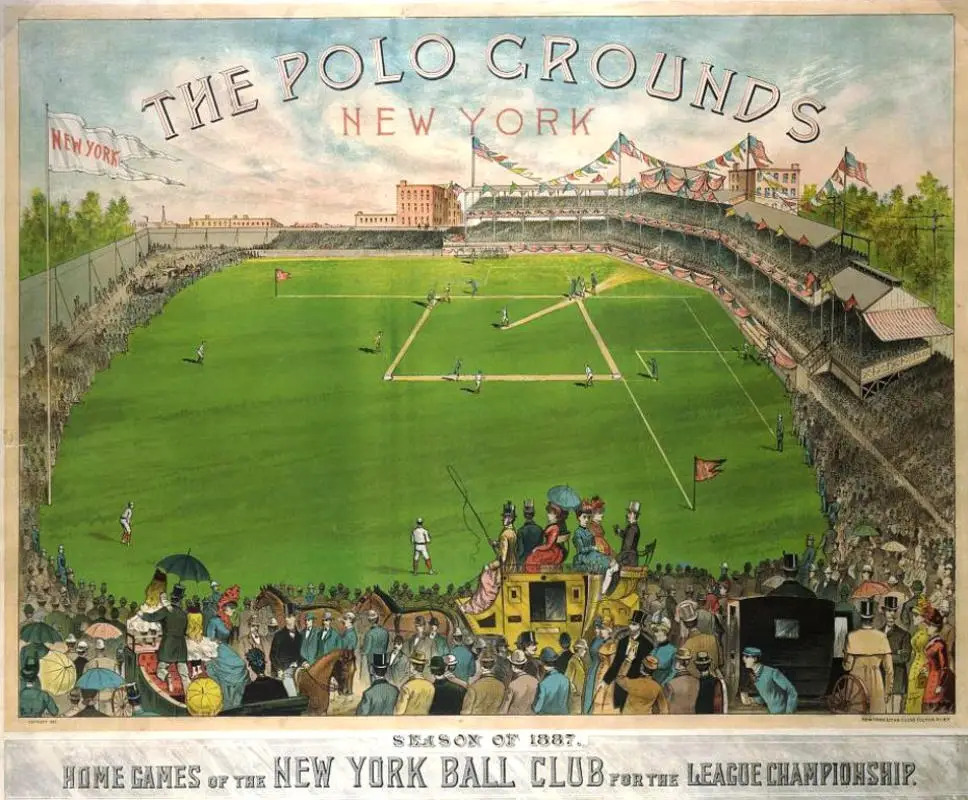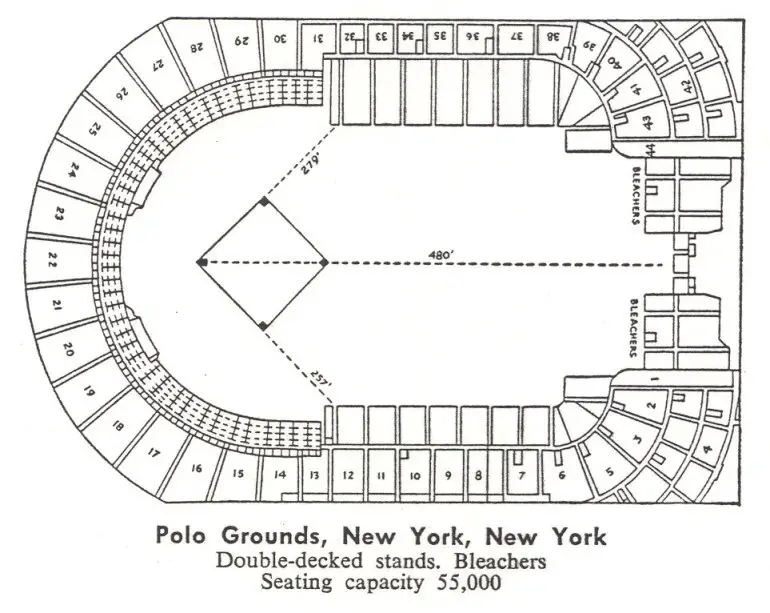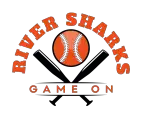Tenant: New York Giants, Yankees, & Mets
Capacity: 16,000 originally, 54,555 final
Surface: Grass
Cost: $300,000
Opened: June 28, 1911
Dimensions: 277-L, 455-C, 258-R (original), 279-L, 475-C, 257-R (final)
Architect: Osborn Engineering
Location: Along Eighth Avenue, Harlem River Drive, West 159th St.
History Of Polo Grounds Stadium
The Polo Grounds were actually made up of three different stadiums in slightly different locations. They were all found in Upper Manhattan and they were home to some very popular teams that we still know today – the New York Giants, the Yankees, and the Mets.
The first Polo Grounds stadium was built in 1880 when John Day rented a parcel to create a single-tier grandstand to be used by his baseball team, the Metropolitans. This was found in Central Park.
In 1883 the New York Gothams were members of the National League and thus a second deck was added to the original Polo Grounds. Two baseball diamonds could now fit within the stadium so both teams could share it.

The Gothams were renamed to the Giants before moving from the original Polo Grounds to the second incarnation, which was not too far away from the original. This stadium was originally called the Brotherhood Park but was renamed the Polo Grounds when the Giants bought it in 1891.
This stadium was made predominantly of wood and, after an unfortunate fire that destroyed almost the entire stadium, the New York Giants had to relocate to the third Polo Grounds.
The third was built by Henry Beaumont and was constructed from steel and concrete rather than wood. This stadium cost $500,000 to build and was first opened with a capacity of 16,000 in 1911.
The Yankees moved into the Polo Grounds in 1913, although they were evicted in 1922. This caused them to build the Yankee Stadium with a capacity of 58,000. Not to be outdone by the Yankees, the Giants then invested in another expansion of the Polo Grounds to increase the capacity to just under 55,000.
The Polo Grounds was demolished on April 10, 1964, with the last game being played on September 18, 1963.
Who / What Is It Named After
Polo Grounds was originally a universal name for several ballparks at the beginning of the 1880s. The first Polo Grounds was situated in the northeast corner of Central Park, between 100th and 112th. This is where the game of polo was played most often.
The name Polo Grounds is a literal explanation of what guests could expect at the stadium.
When Did It Open
The Polo Grounds opened on June 28th, 1911. It closed on September 18th, 1963, 52 years after it first opened.
What Team Plays There
Three popular teams played at the Polo Grounds, including the New York Giants, the Yankees, and the Mets.
Location
The first version of the Polo Grounds was situated between the Harlem River and Coogan’s Bluff in Upper Manhattan. It has since been replaced by housing and industrial estates.
The second was in Coogan’s Hollow, which is a meadow below Coogan’s Bluff. This was found between 155th and 157th Street. Another was alongside this second Polo Grounds between 157th and 159th, also called the Polo Grounds.
Capacity (Seated & Standing)
The first Polo Grounds only had a seated capacity of 12,000.
When the second stadium was originally built, the capacity was only 16,000. Once the game began gaining popularity, the Polo Grounds were built to more than double the capacity to 23,000 in 1908. By 1911, this had been increased to 31,000 in total. At the time, this was the largest stadium used for Baseball.
The third Polo Grounds was built in 1911 and originally started with a 16,000 capacity. It was built upon until 1922 when it finished with a capacity of almost 55,000 fans.
What Are The Stadium Dimensions
The original dimensions of the Polo Grounds were as follows:
- Left field: 277 feet
- Center field: 455 feet
- Right field: 258 feet
Below are the final dimensions once the final Polo Grounds were built upon and finalized:
- Left field: 279 feet
- Center field: 475 feet
- Right field: 257 feet
Seating Chart
This is a final seating chart for the third Polo Grounds once its capacity had been increased to 55,000.

Seats For Sale
As the stadium is no longer there and in use, you cannot purchase seats for the seasons. However, all hope is not lost if you want a piece of history to call your own.
The Stadium Shoppe is offering a Polo Grounds seat from a New York Giants game. It hasn’t been restored and has been authenticated to ensure that it is from the Polo Grounds.
This chair will set you back $7,500, but can you really put a price on history?
Best Seats
The best seats in the Polo Grounds were nearest the batting area, which was block 20, 21, 22, 23, and 24. As the stadium rounded out, the seats would get further away from the action.
Blocks 1-5 and 39-43 are among the worst seats, being positioned behind the bleachers. All of the blocks had rows of seats, and the closer the row was to the grass, the better the view was.
Notable Features
All of the Polo Grounds came with unique features that were decorative rather than necessarily useful. These included ornate bas relief motifs along the upper deck and decorative relifs of all of the National League teams on top of the upper deck.
An iron fence also sat along the top of the roof, which showcased statues of eagles in equal 20 feet gaps along the entire fence.
Memorabilia
Unfortunately, there is very little out there in the way of memorabilia for the Polo Grounds. Now that the sites have been demolished, new memorabilia doesn’t hold as much value as if it were to be from when the stadium was still being used.
There is the New York Giants chair that we have looked at above, as well as a Polo Grounds stadium baseball on the same website. However, the baseball is newly made and only has a printed image of the stadium on it. The baseball has nothing to do with, nor was it used during the time that the Polo Grounds were still in their prime.
Other modern-day memorabilia include keyrings, posters, and even replicas of the stadium. Some are also selling vintage postcards from the stadium online, so you can find some interesting pieces of memorabilia if you’re willing to look for them online.
Tickets
Again, you cannot get any tickets for new games at the Polo Grounds because they are no longer being used or standing. However, one very interesting thing about the tickets for the Polo Grounds is that some people are still selling them online as vintage pieces of memorabilia.
The price of these tickets ranges from $50 to $100, depending on the seller and the game that the ticket is for.
The tickets are in the form of stubs and the majority of them have been ripped to show that they were used by the original ticket holder. If you’re a fan of collecting vintage sports pieces, the presence of Polo Grounds tickets is very interesting.
You can find tickets for the Polo Grounds for the New York Giants, Yankees, and the Mets. The latter two are much harder to find than the Giants, and this is the same for all sports memorabilia that is related to the Polo Grounds.
Mascot
Unfortunately, Polo Grounds did not have a specific mascot for the stadium. However, Mr. Met was first introduced as the Mets mascot while they were still playing at the Polo Grounds. Mr. Met was a man with a baseball as a head and was first spotted on April 11th, 1962. Sadly this was only one year before the Polo Grounds were demolished and therefore the stadium didn’t get to experience a mascot for very long.
Notable Events
There were many notable events taking place at the Polo Grounds, including 13 of the World Series’, seen in 1905, 1911, 1912, 1913, 1917, 1921, 1922, 1923, 1924, 1933, 1937, 1951, and 1954. Willie Mays’ catch was seen at the Polo Grounds in the 1954 World Series game.
The 1934 and 1942 All-Star Games were also played at the Polo Grounds, and this was the stadium that held the well-loved manager John McGraw.
In 1951, Bobby Thomson’s ‘shot heard around the world’ was first seen at the Polo Grounds on October 3rd, when he made the most famous home run of all time.
Mel Ott also achieved his 500th home run at the Polo Grounds on August 1st, 1945. His final total was 511!
The New York Giants sadly lost their winning streak at the Polo Grounds on September 30th, 1916 when they lost their 27th game, having won the previous 26.
No matter what anyone says about the Polo Grounds, you can’t deny that there were an amazing amount of notable events seen during its 52 years!
